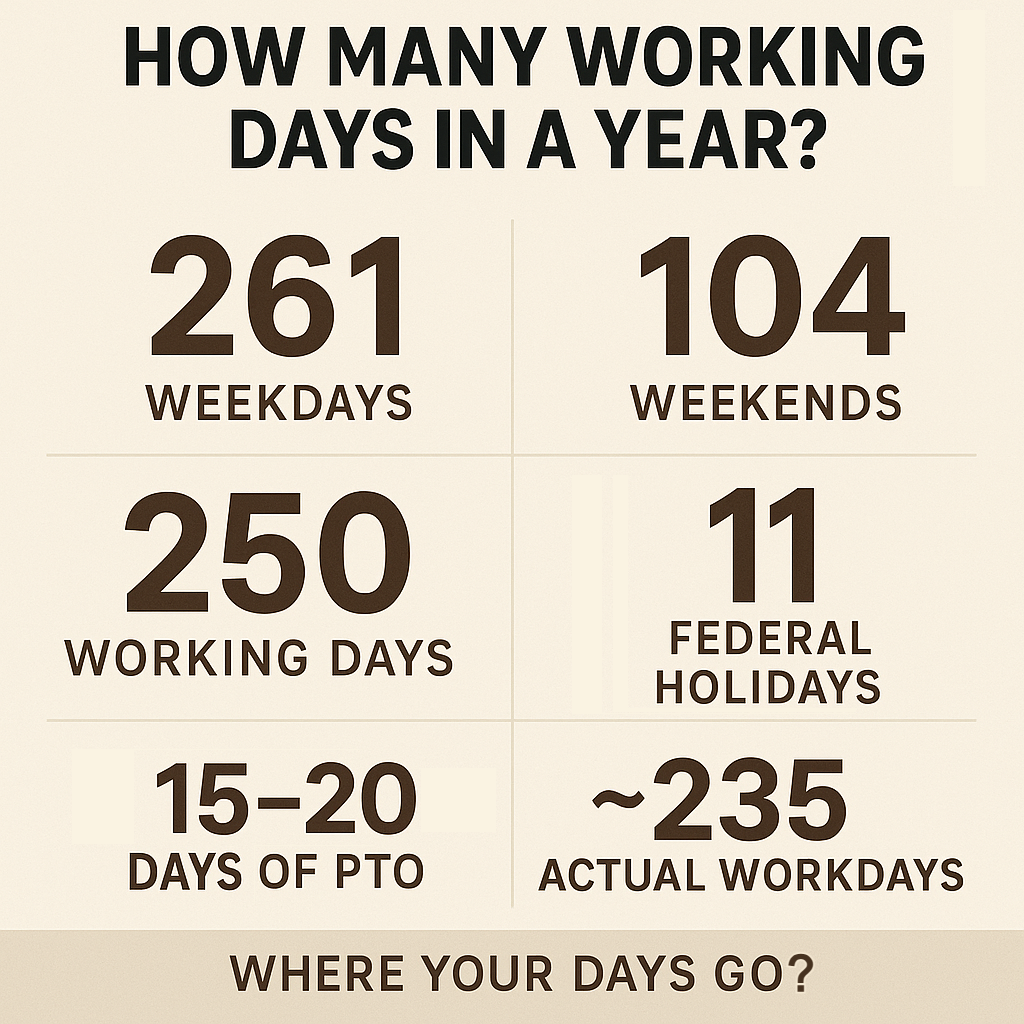2025 Edition
Have you ever wondered how many days you actually spend at work each year? Or how many hours you clock in over 12 months? Of course you have, that’s why you’re here! From planning a new project, budgeting payroll, or to just being curious where all your time is going, knowing these numbers is more useful than you’d think. It’s one of those questions people casually Google but don’t realize how important the answers are. They can dictate things like payroll budgets, PTO policies, scheduling, personal goals, etc.
For businesses, the numbers are the basis of everything from staffing plans to performance metrics. For employees, they shape work-life balance, vacation planning, and how we view our time. The numbers themselves are simple, but once you factor in holidays, time off, and industry-specific quirks, they get a little more interesting.
How Many Working Days in a Year?
Honestly, the answer to “how many working days are in a year?” seems pretty obvious… There are 365 days in a year, right? Subtract weekends, and you’ve got it. But let’s get more precise.
In 2025, there are:
- 104 weekend days (Saturdays and Sundays, as usual)
- 261 weekdays (Monday through Friday)
- Subtract the 11 federal holidays observed nationwide.
- New Year’s Day: January 1.
- Birthday of Martin Luther King, Jr.: Third Monday in January (January 20, 2025).
- Washington’s Birthday: Third Monday in February (February 17, 2025).
- Memorial Day: Last Monday in May (May 26, 2025).
- Juneteenth National Independence Day: June 19.
- Independence Day: July 4.
- Labor Day: First Monday in September (September 1, 2025).
- Columbus Day: Second Monday in October (October 13, 2025).
- Veterans Day: November 11.
- Thanksgiving Day: Fourth Thursday in November (November 27, 2025).
- Christmas Day: December 25.
- That leaves 250 official working days
But, most people don’t actually work all of those days. Paid time off (PTO) factors in. According to the Bureau of Labor Statistics’s 2025 data average full-time workers earn about 15 ~ 20 PTO days per year, but it varies depending on things like tenure and company policies. PTO is normally used for vacation, personal days, and sometimes sick leave.
For our example, we’ll use 15 PTO days (you hard worker, you!). That brings your actual working year down to 235 days.
Example: You work for a mid-sized company offering standard PTO and you take your two weeks of vacation plus a few personal days, you’re realistically working 235 days out of 365 in 2025. That’s still nearly 2/3 of the year spent on the clock! It’s important to remember this when discussing your workload, deliverables, and wellness with your employer/employees.

How Many Work Hours in a Year? (2025)
When people talk about “full-time” work, the go-to is a 40-hour workweek. 40 times 52 (weeks in a year) equals 2,080 total work hours.
Simple, right? Well again, that’s just a starting point.
In reality, not many people work all 2,080 hours. You have holidays. You take vacation. Maybe you’re even lucky enough to get a few personal days or “sick days” thrown in. These all chip away at that total.
Accounting for Time Off:
Let’s revisit those 11 federal holidays. Most employers give you the day off with pay, so you’re not working those days:
- 11 holidays × 8 hours = 88 hours off
Then comes PTO:
Average PTO of 15 days (again, the middle-ground figure)
- 15 days × 8 hours = 120 hours off
Together, that’s 208 hours shaved off the theoretical work year.
Realistic Total Work Hours (2025):
- 2,080 total possible hours
- Minus 88 holiday hours
- Minus 120 PTO hours
- Leaves you with 1,872 actual working hours
Industry Best Practices:
While 2,080 remains the standard “full-time” benchmark, HR departments, project managers, and financial planners often use a slightly more conservative number like 1,870 to 1,920 hours for budgeting and workforce capacity planning. Why? Because they know not everyone burns through their PTO to the last hour, but most will take some time off.
Pro Tip for HR & Finance:
Using 1,900 work hours as a planning estimate for full-time employees gives you a realistic buffer for holidays, vacation, sick days, and those inevitable “life happens” absences. It helps you set attainable productivity goals and prevents unrealistic expectations when forecasting labor costs or project timelines.
Variable Work Hours
Of course, it is worth noting that not all workers fit neatly into the 40-hour mold:
- Healthcare workers often work 12-hour shifts, reducing their workdays but keeping total hours close to the 2,000 range. However, overtime can swing that number a lot higher.
- Tradespeople (electricians, HVAC techs, etc.) can fluctuate with seasonal demand, sometimes blowing way past the 2,080 mark with overtime. One the flip side, they could very well slow down during off-peak months.
- Gig workers and Freelancers might aim for income goals rather than hours, making the “work hours per year” concept much more fluid. Their work year is based on outcome-based performance and measured in gigs completed.
- Remote workers and Tech employees are seeing shifts toward flexible scheduling, but total annual hours often stay in the same ballpark. Instead of clocking/logging into a strict 40-hour week, many focus on final results over time spent.
Even so, for budgeting, payroll, and general workforce planning in 2025, 1,872 to 1,920 hours per year is a safe, realistic figure for the average full-time employee.

Why The Numbers Matter: HR, Budgets & Work-Life Balance
Knowing the number of working days in a year or working hours in a year is more than just a fun fact for trivia night. It’s really important data for anyone involved in business planning, HR strategy, finance, even your career progression.
Here’s why these numbers matter more than you think:
Payroll, Compensation & Staffing
For HR and finance teams, the total number of workdays and hours directly affects payroll and workforce costs… it isn’t just theoretical.
- Salaried employees are typically budgeted using the 2,080-hour figure, even if actual hours worked dip due to holidays and/or PTO.
- For hourly workers, this number can influence calculating overtime, benefit eligibility (especially for ACA compliance), and labor cost forecasting.
- Workforce planners use these numbers to calculate Full-Time Equivalents (FTEs). If a project needs 3,840 hours of labor, that equates to 2 FTEs working 1,920 hours each (after the adjustment for PTO and holidays).
Not having or understanding the real number of available work hours per employee can lead to overestimating their productivity and underestimating your costs.
Project Timelines & Capacity Planning
For project managers and operations teams, knowing how many workdays are in a year is needed for realistic scheduling.
- Setting deadlines without accounting for holidays, PTO, or even slowdowns during seasonal lulls is a classic recipe for missed goals.
- A year might look like 365 days, but for most employees, you’re realistically working right around the 235 days mark. That’s a huge difference when plotting out deliverables or staffing customer service shifts.
Example:
A software development team aiming to release a new product “in six months” needs to understand that six calendar months doesn’t equal six months of uninterrupted workdays. Federal holidays, vacation time, and even company-wide “off days” need to be considered when planning the timeline.
PTO Policies & Employee Retention
Time off has become a big factor in job satisfaction and retention. Companies that understand (and respect) the limits of their employees and working days per year are in a much better position to:
- Set fair PTO policies that balance business needs with employee well-being.
- Avoid employee burnout by acknowledging that your people aren’t robots! Having 2/3 of their year as workdays we should prioritize output and efficiency, not just the sheer amount of hours logged.
- Compete for talent in industries where work-life balance is a top priority (especially in tech, creative, and remote-friendly roles).
Smart HR leaders are increasingly tying their PTO policies to mental health initiatives. Understanding that rest isn’t a perk-of-the-job, it is a necessity for sustainable productivity. Remember, employees are not robots!
Productivity Benchmarks & Goal Setting
Understanding how many working hours and days are in a year can also help managers set real and achievable performance goals.
- Sales targets, project milestones, and service quotas all rely on employee availability. Someone has to do the work.
- Without solid grounding, it’s easy to set goals that look good on paper but are realistically impossible to hit in practice. Not many goals are possible if you have an unrealistic idea of how many hours your people can really work.
Pro Insight:
Top-performing organizations use actual workdays/hours to reverse-engineer performance metrics. For instance, if a sales rep is expected to close 120 deals per year, that breaks down to one deal every two workdays, not every calendar day.
Budgeting & Forecasting
Now, for CFOs and finance teams, these numbers are foundational.
- Labor costs are, typically, the largest expense for most organizations.
- Annual budgets, cost-per-employee metrics, and financial forecasts all have to come from an accurate understanding of how many hours and days employees will be working.
- Overlooking holidays or scheduled PTO can ruin your projections, especially for companies that are scaling quickly or operating on tight margins. They simply cannot afford to NOT pay attention to these numbers.
In Short:
There are about 235 working days and ~1,872 effective work hours in 2025. Knowing these numbers may be good for trivia night, but it’s also strategic intelligence. It keeps realistic expectations aligned, protects your employee’s well-being, and keeps your budgets honest.
Trending Job Sectors & Their Schedules (2025)
We have gone over the base of the work year, it sits at around 2,080 hours and 250 workdays. Not every industry plays by those rules though, some sectors flex, compress, or completely ignore traditional schedules in favor of more modern or practical arrangements.
We found the most-searched job sectors in 2025, how they are scheduling and why those annual workday and hour figures still matter… even for the most flexible roles or the most equal opportunity employer.
1. Healthcare: Always On, Always Needed
Healthcare has and continues to dominate career search trends in 2025, with the top searches being for:
- Registered Nurses (RNs)
- Medical Technicians
- Therapists & Mental Health Professionals
Unlike traditional 9 to 5 or office jobs, healthcare doesn’t take weekends or holidays off. Hospitals, urgent care centers, and assisted care facilities need 24/7 coverage every day of the year.
- Common Schedule: Often 3 days per week with 12-hour shifts (e.g., 3×12)
- Despite fewer actual workdays, total annual hours often stay pretty close to or go over 2,000 due to overtime, staffing shortages and those little favors.
- PTO exists, but staffing needs can make it difficult to schedule, leading to unused vacation time for many frontline workers.
Main Point:
Their total annual hours may technically look similar to office jobs, but the increased physical and emotional toll of this kind of shift work requires careful planning to vigilantly prevent burnout.
2. Remote & Hybrid Tech Jobs: Productivity Over Presence
The tech sector is continuing its shift from measuring the time worked to measuring the results delivered.
- A lot of places are getting into asynchronous work, allowing employees to choose when they work, as long as deliverables and deadlines are met.
- Interest in four-day workweeks has spiked, with some companies reducing from 40-hour weeks to 32-hour weeks while the employees still make full salaries.
- Even with the obvious shifts toward more flexibility, HR and finance teams seem like they’ll continue to budget based on 2,080 hours for simplicity in compensation and benefits structures.
Main Point:
For remote tech workers, the spirit of the 40-hour workweek is fading, but it’s still a useful starting point for planning salaries, benefits, and staffing capacity.
3. Skilled Trades: Feast, Famine & Overtime
Skilled trades like electricians, plumbers, HVAC techs, etc. have recently surged in search popularity thanks to strong job prospects and the sector’s transparent pay scales.
- Schedules vary by project demand, seasonality, and location. There are many types of different schedules in skilled trade work. Some of the more common, uncommon schedules are:
- 4/10 Schedule: Four 10-hour days and three days off each week.
- 9/80 Schedule: Working nine days over two weeks, with one extra day off every other week.
-
- 2-2-3 Schedule: Employees work two 12-hour shifts, have two days off, work three 12-hour shifts, and then have two days off.
- 4 on 4 off: A common 12-hour shift pattern where employees work four consecutive shifts and then have four consecutive days off.
- 5 on 3 off: Another rotating split is working five consecutive days followed by three full days off.
- Tradespeople may work well beyond 2,080 hours annually, this is attributed to busy seasons, with overtime playing the biggest role in their total compensation.
- During slower periods, hours can drop significantly, leading to fluctuations that salaried workers don’t face or have to plan for.
Main Point:
For budgeting, skilled trades employers must balance variable labor costs while making sure they can still meet demand during peak periods.
4. Real Estate & Notary Services: Flexibility Rules
Becoming a real estate agent or notary public stays highly searched in 2025, partly due to low barriers for getting your foot in the door and their flexible work schedules.
- Real estate agents very rarely, if ever, follow a traditional 9-to-5 schedule. Client availability (nights, weekends and even holidays) and market prices dictate their hours. Fun Fact: According to the National Association of Realtors, “Top-producing real estate agents often report working 50-60 hours per week during busy periods. That’s a lot of flexibility.”
- A notary public working with real estate agents, title companies, or legal firms might stay quite busy, while others might only see sporadic demand. Volume matters, and this service is generally fit around another source of income. Full-time notaries involved in loan signings can work upwards of 30-40 appointments a week, depending on market needs.
Main Point:
Both of these roles share one main thing: your annual work hours can be as high (or low) as your hustle allows. Because, while technically “self-scheduled,” these roles still orbit around the traditional workweek when interacting with banks, title companies, or even just clients operating on Monday–Friday timelines.
5. Aviation: Regulated Hours, Irregular Schedules
Aviation careers, specifically pilots and flight attendants, maintain a very strong search interest, but they come with their own unique scheduling challenges.
- Airline crew schedules are built around flight hours, with strict regulations on maximum monthly and annual limits to ensure safety.
- Irregular hours (red-eye flights, multi-day trips) make their work year hard to compare directly to traditional 9 to 5 or office jobs.
- Despite this, airline HR teams still use the standard 1,880 annual work hour estimates for payroll and staffing models.
Main Point:
Staffing for truly continuous operation (airlines fly 365 days/year) requires overlapping and rotational schedules. Which can make the total annual work hours one of the most important budgeting figures, even if individual workdays are irregular.
6. Honorable Mentions: Gig Economy & Side Hustles
Gig work aka “side hustles” are still on the rise in 2025 too. This includes everything from rideshare driving and delivery apps to freelance content creation, online tutoring, and even mobile car detailing.
The traditional concept of a “workday” doesn’t really apply here. In the gig economy, you decide how often you work, when you clock in, and what kind of jobs you take on.
- Night owls might prefer overnight delivery shifts or rideshare driving during late-night weekends.
- Not a morning person? Consider second-shift opportunities like bartending, security, or evening warehouse gigs.
- For gig workers, hitting your income target is the goal. You can work as much, or as little, as needed to meet your financial goals.
Main Point:
Gig work is famously flexible and self-directed. Some gig workers treat their jobs as supplemental income streams, but others piece together multiple gigs to build a workload that out-earns a traditional schedule.
Whether you’re eyeing a role in healthcare, tech, trades, or launching your side hustle (you still want to be professional), it all starts with a lasting first impression. Grab one of our professionally designed free resume templates. They’re clean, modern, and easy to customize.
Why Knowing Your Workdays & Hours Matters
When you search for “how many working days in a year” or “how many work hours in a year,” you’re usually looking a simple number. But every real working year depends on a mix of:
- Federal holidays
- Personal vacation time
- Industry norms
- Individual flexibility
- Economic demands
Most full-time employees in 2025 will work around 235 actual workdays and roughly 1,870–1,920 working hours after accounting for time off. These averages play a big part in scheduling:
- Employers use these figures for everything from payroll to capacity planning, staffing models, and benefits policies.
- Employees can use this information to set realistic expectations for workload, income potential, and work-life balance.
- Gig Workers/Independent Contractors operate differently, but even they benefit from understanding how their time maps out across the year… Especially when it comes to taxes, financial planning, or making the leap to full-time self-employment.
Evolving Workplaces, Same Scheduling
Even as modern work trends shift to hybrid models, flexible hours, and performance-based evaluation, the basics of scheduling stays the same.
- Projects are always going to need timelines.
- Budgets still need accurate labor cost projections to be profitable.
- Burnout prevention still requires knowing and acknowledging employee limits.
Final Thought
Whether you’re managing a team, running payroll, freelancing your way to freedom, or simply planning your next vacation, understanding how work fits into your year is very helpful information.

Sources:
- Bureau of Labor Statistics (BLS), 2025 reports: https://www.bls.gov/opub/mlr/2025/
- U.S. Office of Personnel Management (OPM) Holiday Calendar 2025: https://www.opm.gov/policy-data-oversight/pay-leave/federal-holidays/#url=2025
- Google Trends, Career Search Volumes Q1 2025: https://trends.google.com/home?hl=en-US
- SHRM Workplace PTO Policies Survey 2025: https://www.shrm.org/topics-tools/news/benefits-compensation/paid-time-benefits-survey




